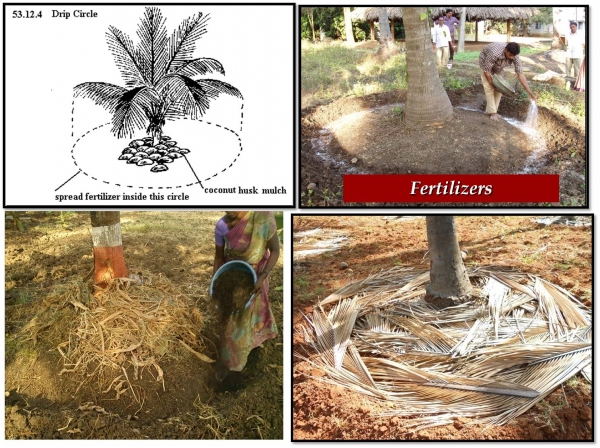Manuring:
--------
Regular manuring right from the first year of planting is essential for good vegetative growth, early flowering and bearing and high yield of coconut palms.
Application of chemical fertilizers:
-----------------------------------
The first application of chemical fertilizers should be done three months after planting. The quantity of fertilizer to be applied is approximately one tenth of the recommend dose of fertilizer for adult palms. During the second year, one third of the dosage recommended for adult palms ma)` be applied in two split doses in May-June and September-October. This dosage may be doubled during the third year. From the fourth year onwards, fertilizers may be applied at the rate recommended for adult palms. An application of 1500 g N, 0.750 g P, and 1500 g K per palm per year is generally recommended for adult plantations. To supply the above quantity of nutrients for an adult palm, it is necessary to apply about 3.261 kg urea, 4.688 kg single super phosphate and 2.500 kg of muriate of potash with two split doses. If coconut mixture (10:5:20) is used, 5 kg of the same is to be applied in two split doses. Rock phosphate is recommended as an ideal and cheaper carrier of phosphorus in laterite and acidic soils.
Fertilizers may be applied in two split doses for the rainfed palms. After the receipt of summer showers, one-third of the recommended dose of fertilizers may be spread around the palms within a radius of 1.8 m and forked in. Circular basins of 1.8 m radius and 25 cm depth may be dug during August-September and green leaf or compost at the rate 30 kg per palm may be spread in the pits. The remaining two-third of the recommended dose of fertilizers may be spread over the green leaf or compost and covered.

If the palms are irrigated, the fertilizers can be applied in 4 or more equal splits avoiding the heavy rainfall period of the area. If there is drip irrigation facility, then the water soluble fertilizers like Urea, DAP, phosphoric acid (commercial grade) and muriate of potash can be applied along with drip irrigation in 6 equal splits. Through fertigation, it is recommended to provide 91 g urea, 33 ml phosphoric acid and 170 g muriate of potash per palm per application. When DAP is used it is recommended to provide 70 g urea, 60 g DAP and 170 g muriate of potash for a single dose per palm. When the recommended doses of phosphatic fertilizers are applied continuously, the available phosphorus in the soil goes up. When it is more than 20 ppm, application of phosphatic fertilizers can be skipped off for a few years until the level goes below 20 ppm. If the level is 10 to 20 ppm, half of the recommended P20- can be applied. For coconut palms showing yellowing of leaves due to Magnesium deficiency 0.5 kg of magnesium sulphate can be applied in the basins along with other fertilizers during September-October.

Application of organic manures
Application of sufficient quantity of organic manure improves the soil characteristics and provides nutrients to coconut palms. Organic matter addition enhances moisture retention capacity of soil and the bulk density of soils is reduced thereby increasing aeration, drainage and water intake. Organic manuring also helps in enhancing soil microbial activity and recycling of minerals. Organic manures such as farmyard manure, compost, green leaf manure or vermicompost can be applied to coconut. Circular basins of 1.8 m radius and 25 cm depth may be dug during August-September and green leaf or compost @ 30 kg per palm may be spread in the basin.
Basin management with legume cover crops
An agro-technique has been developing to generate significant quantities of organic manure and nitrogen in coconut gardens utilizing the leguminous cover crops. It involves cultivation of leguminous creepers having symbiotic association with efficient Rhizobium strains in coconut basins and interspaces during the monsoon period and incorporation of biomass generated to the palms at the maximum vegetative growth of legumes. The field experiments on basin management with legumes in adult coconut plantations revealed the effectiveness of this technique to substitute fertilizer nitrogen for coconut upto 30 per cent. The effectiveness of the legume treatment as a component in the management programme for root (wilt) disease of coconut has also been demonstrated. Pueraria phaseoloides, Mimosa invisa and Calopogjnium irwamoides are the species of legumes superior in biomass and nitrogen contribution in coconut basins. They contribute about 15-25 kg of biomass and 100-200 g of nitrogen in coconut basins during a growth period of 140-150 days in monsoon season. Pelleting of inoculated seeds with neutral or inert materials enhances nodulation by introduced rhizobia in acidic soils.
Growing Glyricidia as green manure crop
Generation of large quantities of nitrogen rich biomass is also possible through the cultivation of the fast growing leguminous tree crop, Glyricidia in the coconut plantations. It can also be grown in littoral sandy soils where no other green manure can establish. Application of glyricidia prunings from the interspace of one hectare of coconut garden to the coconut plantation in littoral sandy soil could meet a major portion of nitrogen (90%), part of phosphorous (25%) and potassium (15%) of the recommended dose of fertilizer. It acts as a source of slow release fertilizer in addition to improving the water holding capacity, however, if adequate quantity of glyricidia is not available, 50 per cent of N can be met by inorganic + 50 per cent through glyricidia. This resulted in 44 per cent increase in coconut yield in comparison to the application of inorganic fertilizer alone to coconut palms in sandy soil.

